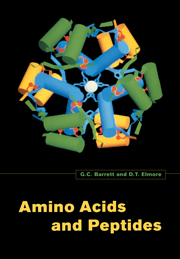Book contents
- Frontmatter
- Contents
- Foreword
- 1 Introduction
- 2 Conformations of amino acids and peptides
- 3 Physicohemical properties of amino acids and peptides
- 4 Reactions and analytical methods for amino acids and peptides
- 5 Determination of the primary structure of peptides and proteins
- 6 Synthesis of amino acids
- 7 Methods for the synthesis of peptides
- 8 Biological roles of amino acids and peptides
- 9 Some aspects of amino-acid and peptide drug design
- Subject index
2 - Conformations of amino acids and peptides
Published online by Cambridge University Press: 05 June 2012
- Frontmatter
- Contents
- Foreword
- 1 Introduction
- 2 Conformations of amino acids and peptides
- 3 Physicohemical properties of amino acids and peptides
- 4 Reactions and analytical methods for amino acids and peptides
- 5 Determination of the primary structure of peptides and proteins
- 6 Synthesis of amino acids
- 7 Methods for the synthesis of peptides
- 8 Biological roles of amino acids and peptides
- 9 Some aspects of amino-acid and peptide drug design
- Subject index
Summary
Introduction: the main conformational features of amino acids and peptides
This topic has been thoroughly developed insofar as the conformational behaviour of amino acids and peptides in aqueous solutions is concerned. The main driving force for conformational studies has been the pharmaceutical interest in the interactions of biologically active amino acids and peptides with tissue, particularly with cell receptors. The solid-state behaviour of amino acids and peptides, though less relevant in the pharmaceutical context, has not escaped investigation. This is because of the wider distribution and greater ease of use of X-ray crystallography equipment nowadays.
The conformational behaviour of N-and C-terminal-derivatised amino acids and peptides in organic solvents has also been studied, particularly by nuclear magnetic resonance and circular dichroism spectrometric techniques (in which advances in instrumentation have been very considerable; see Chapter 3).
Configurational isomerism within the peptide bond
The amide group shows restricted flexibility because its central–NH–CO–bond has some double-bond character due to resonance stabilisation [–NH–CO– ⇔–N+H=C(O-)–]. The energy barrier that this creates is insufficient to prevent rotation, but sufficient to ensure that geometrical isomers exist under normal physiological conditions of temperature and solvent, so ensuring that a particular peptide can exist in a variety of conformations, often an equilibrium mixture of several conformations, in solutions.
- Type
- Chapter
- Information
- Amino Acids and Peptides , pp. 20 - 31Publisher: Cambridge University PressPrint publication year: 1998



